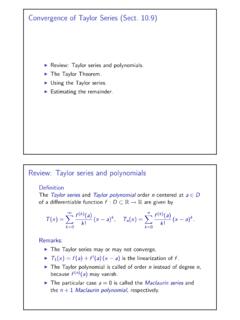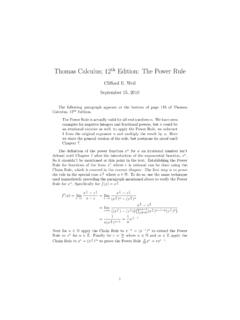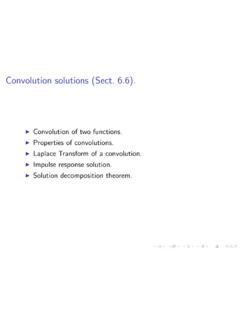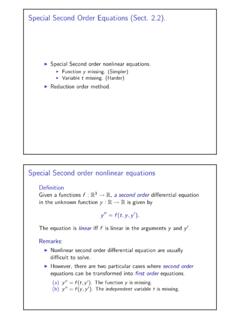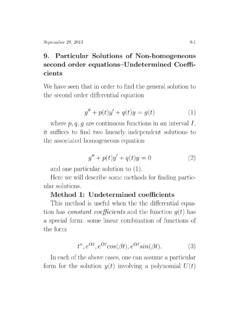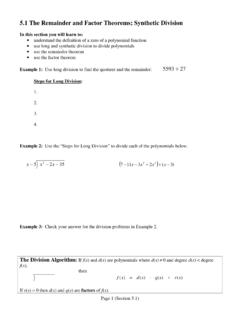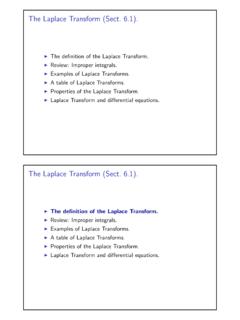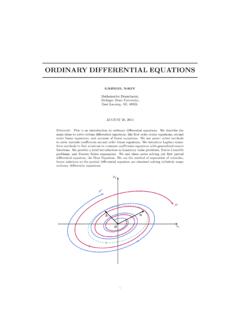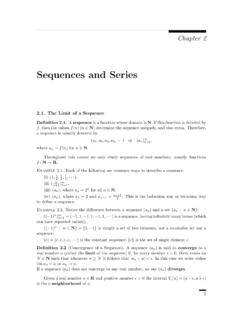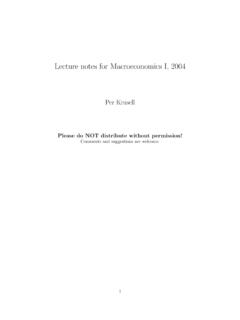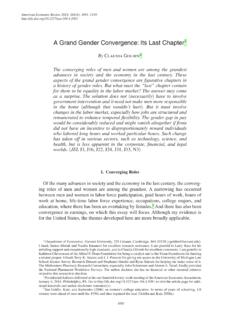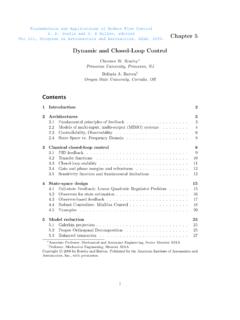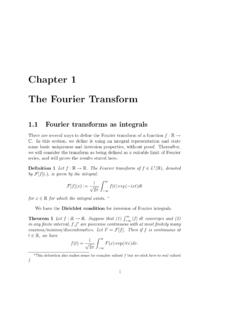Transcription of Functional Analysis Lecture Notes
1 Functional Analysis (Math 920) Lecture Notes for Spring 08 Jeff SchenkerMichigan State UniversityE-mail and course informationPart 1. Hahn-Banach Theorem and ApplicationsLecture 1. Linear spaces and the Hahn Banach TheoremLecture 2. Geometric Hahn-Banach TheoremsLecture 3. Applications of Hahn-BanachPart 2. Banach SpacesLecture 4. Normed and Banach SpacesLecture 5. Noncompactness of the Ball and Uniform ConvexityLecture 6. Linear Functionals on a Banach SpaceLecture 7. Isometries of a Banach SpaceHomework IPart 3. Hilbert Spaces and ApplicationsLecture 8. Scalar Products and Hilbert SpacesLecture 9. Riesz-Frechet and Lax-Milgram TheoremsLecture 10. Geometry of a Hilbert space and Gram-Schmidt processPart 4. Locally Convex SpacesLecture 11. Locally Convex Spaces and Spaces of Test FunctionsLecture 12. Generation of a LCS by seminorms and Fr echet SpacesLecture 13. The dual of an LCSL ecture 14. Spaces of distributionsLecture 15.
2 Applications: solving some PDE sLecture 16. The Dirichlet problemPart 5. Weak convergence and Weak TopologyiiiivCONTENTSL ecture 17. Dual of a Banach spaceLecture 18. Riesz-Kakutani theoremLecture 19. Weak convergenceLecture 20. Weak sequential compactness, weak convergence and the weak?topologyLecture 21. An application: positive harmonic functionsPresentation topicsHomework IIPart 6. ConvexityLecture 22. Convex sets in a Banach spaceLecture 23. Convex sets in a Banach space (II) Lecture 24. Krein-Milman and Stone-WeierstrassLecture 25. Choquet type theoremsPart 7. Bounded Linear MapsLecture 26. Bounded Linear MapsLecture 27. Principle of Uniform Boundedness and Open Mapping TheoremLecture 28. The Spectrum of a Linear MapLecture 29. Some examplesPart 8. Compact Linear MapsLecture 30. Compact MapsLecture 31. Fredholm alternativeLecture 32. Spectral Theory of Compact MapsHomework IIIPart 9. Compact Linear Maps in Hilbert SpaceLecture 33.
3 Compact Symmetric OperatorsLecture 34. Min-MaxLecture 35. Functional calculus and polar decompositionComments and course informationThese are Lecture Notes for Functional Analysis (Math 920), Spring 2008. The text forthis course isFunctional Analysisby Peter D. Lax, John Wiley & Sons (2002), referred toas Lax below. In some places I follow the book closely in others additional material andalternative proofs are excellent texts include M. Reed and B. Simon,Methods of Modern Mathematical Physics Vol. I: FunctionalAnalysis, Academic Press (1980). W. Rudin, Functional Analysis , McGraw-Hill, 2nd ed. (1991).(As needed, these will be referred to below as Reed and Simon and Rudin respectively.)vPart 1 Hahn-Banach Theorem and ApplicationsLECTURE 1 Linear spaces and the Hahn Banach TheoremReading: Chapter 1 and of LaxMany objects in mathematics particularly in Analysis are, or may be described interms of, linear spaces(also called vector spaces).
4 For example:(1)C(M) = space of continuous functions (RorCvalued) on a manifoldM.(2)A(U) = space of analytic functions in a domainU C.(3)Lp( ) ={pintegrable functions on a measure spaceM, }.The key features here are the axioms of linear algebra, linear spaceXover a fieldF(in this courseF=RorC) is a set onwhich we have defined(1) addition:x,y X7 x+y Xand(2) scalar multiplication:k F, x X7 kx Xwith the following properties(1) (X,+) is anabeliangroup (+ is commutative and associative and identity andinverses.) identity is called 0 ( zero ) inverse ofxis denoted x(2) scalar multiplication is associative:a(bx) = (ab)x, distributive:a(x+y) =ax+byand (a+b)x=ax+bx,and satisfies 1x= follows from the axioms that 0x= 0 and x= ( 1) from linear algebra that a set of vectorsS Xis linearly independentifn j=1ajxj= 0 withx1,..,xn S= a1= =an= 0and that the dimensionofXis the cardinality of a maximal linearly independent set dimension is also the cardinality of a minimal spanning set, where the spanof a setSis the setspanS={n j=1ajxj:a1.}
5 ,an Randx1,..,xn S},andSis spanning, or spansX, if spanS= or less, Functional Analysis is linear algebra done on spaces with infinite this way it may seem odd that Functional Analysis is part of Analysis . For finitedimensional spaces the axioms of linear algebra are very rigid: there is essentially only1-11-21. LINEAR SPACES AND THE HAHN BANACH THEOREMone interesting topology on a finite dimensional space and up to isomorphism there is onlyone linear space of each finite dimension. In infinite dimensions we shall see that topologymatters a great deal, and the topologies of interest are related to the sort of Analysis thatone is trying to explains the second word in the name Functional Analysis . Regarding Functional , this is an archaic term for a function defined on a domain of functions. Since most ofthe spaces we study are function spaces, likeC(M), the functions defined on them are functionals.
6 Thus Functional Analysis . In particular, we define a linear functionalto bea linear map`:X F, which means`(x+y) =`(x) +`(y) and`(ax) =a`(x) for allx,y Xanda , one is able to define a linear Functional at first only for a limited set of vectorsY X. For example, one may define the Riemann integral onY=C[0,1], say, whichis a subset of the spaceB[0,1] of all bounded functions on [0,1]. In most cases, as in theexample, the setYis a subsetY Xof a linear space is a linear subspaceif it is closedunder addition and scalar multiplication:y1,y2 Yanda F= y1+ay2 functionals defined, at first, on a subspace of a linear space ofRwe (Hahn (1927), Banach (1929)).LetXbe a linear space overRandpareal valued function onXwith the properties(1)p(ax) =ap(x)for allx Xanda >0(Positive homogeneity)(2)p(x+y) p(x) +p(y)for allx,y X(subadditivity).If`is a linear Functional defined on a linear subspace ofYand dominated byp, that is`(y) p(y)for ally Y, then`can be extended to all ofXas a linear Functional dominatedbyp, so`(x) p(x)for allx [0,1] andY=C[0,1].
7 OnY, let`(f) = 10f(t)dt(Riemannintegral). Letp:B Rbep(f) = sup{|f(x)|:x [0,1]}. Thenpsatisfies (1) and (2)and`(f) p(f). Thus we can extend`toallofB[0,1]. We will return to this example andsee that we can extend`so that`(f) 0 wheneverf 0. This defines a finitely additiveset function onall(!) subset of [0,1] via (S) =`( S). For Borel measurable sets it turnsout the result is Lebesgue measure. That does not follow from Hahn-Banach proof of Hahn-Banach isnot constructive, but relies on the following result equivalentto the axiom of (Zorn s Lemma).LetSbe a partially ordered set such that every totallyordered subset has an upper bound. ThenShas a maximal understand the statement, we partially ordered setSis a set on which an order relationa bisdefined for some (but not necessarily all) pairsa,b Swith the following properties(1) transitivity: ifa bandb cthena c(2) reflexivity: ifa afor alla S.(Note that (1) asserts two things: thataandcare comparable and thata c.)
8 A subsetTofSis totally orderedifx,y T= x yory x. An elementu Sis an upper boundforT Sifx T= x u. A maximal elementm Ssatisfiesm b= m= LINEAR SPACES AND THE HAHN BANACH THEOREM1-3 Proof of apply Zorn s Lemma, we need a poset,S={extensions of`dominated byp}.That isSconsists of pairs (` ,Y ) with` a linear Functional defined on a subspaceY Yso that` (y) =`(y), y Yand` (y) p(y), y Y .OrderSas follows(`1,Y1) (`2,Y2) Y1 Y2and`2|Y1=` a totally ordered subset ofS, let (`,Y) beY= {Y : (` ,Y ) T}and`(y) =` (y) fory Y .SinceTis totally ordered the definition of`is unambiguous. Clearly (`,Y) is an upperbound forT. Thus by Zorn s Lemma there exists a maximal element (`+,Y+).To finish, we need to see thatY+=X. It suffices to show that (` ,Y ) has an extensionwheneverY 6=X. Indeed, letx0 X. We want` onY ={ax0+y:y Y, a R}. Bylinearity we need only define` (x0). The constraint is that we needa` (x0) +` (y) p(ax0+y)for alla,y. Dividing through by|a|, sinceY is a subspace, we need only show ` (x0) p(y x0) ` (y)( )for ally Y.
9 We can find` (x0) as long as` (y ) p(y x0) p(x0+y) ` (y) for ally,y Y ,( )or equivalently` (y +y) p(x0+y) +p(y x0) for ally,y Y .( )Since` (y +y) p(y +y) =p(y x0+y+x0) p(x0+y) +p(y x0),( ), and thus ( ), holds. So we can satisfy ( ). In finite dimensions, one can give a constructive proof involving only finitely many infinite dimensions the situation is a quite a bit different, and the approach via Zorn slemma typically involves uncountably many choices. Lecture 2 Geometric Hahn-Banach TheoremsReading: , of may use Hahn-Banach to understand something of the geometry of linear spaces. Wewant to understand if the following picture holds in infinite dimension:Figure a point from a convex set by aline setS Xis convexif for allx,y Sandt [0,1] we havetx+ (1 t)y pointx S Xis an interior pointofSif for ally X >0 |t|< = x+ty can a define a topology using this notion, lettingU Xbe open allx Uare interior. From the standpoint of abstract linear algebra this seems to bea natural topology onX.
10 In practice, however, it haswaytoomany open sets and wework with weaker topologies that are relevant to the Analysis under considerations. Much offunctional Analysis centers around the interplay of different are aiming at the following2-12-22. GEOMETRIC HAHN-BANACH a non-empty convex subset ofX, a linear space overR, andsupposeKhas at least one interior point. Ify6 Kthen a linear Functional `:X `(x) `(y)for allx K,( )with strict inequality for all interior is the hyperplane separation theorem, essentially validates the picture drawnabove. A set of the form{`(x) =c}with`a linear Functional is a hyperplane and the sets{`(x)< c}are half spaces. To accomplish the proof we will use Hahn-Banach. We need a dominating Xbe convex and suppose 0 is an interior point. The gaugeofK(with respect to the origin) is the functionpK:X Rdefined aspK(x) = inf{a:a >0 andxa K}.(Note thatpK(x)< for allxsince 0 is interior.) positive homogeneous and homogeneity is clear (even ifKis not convex).
